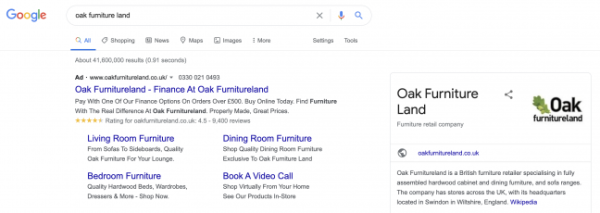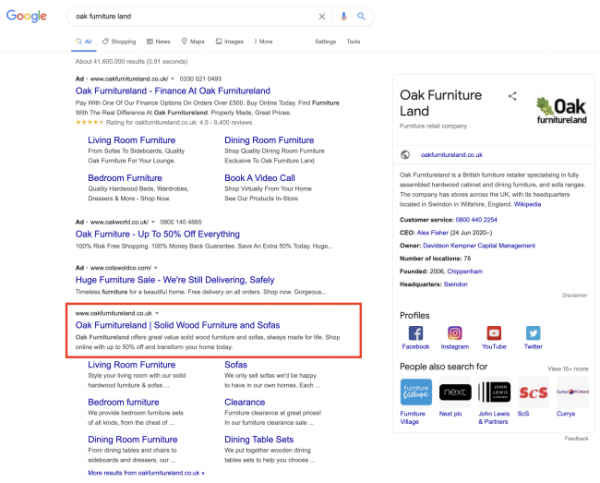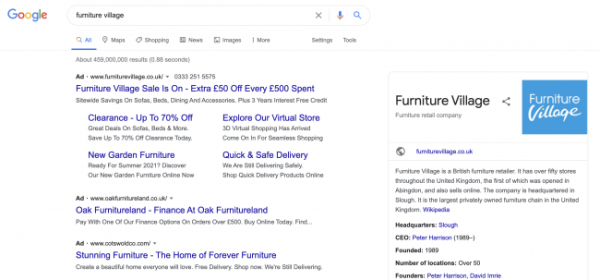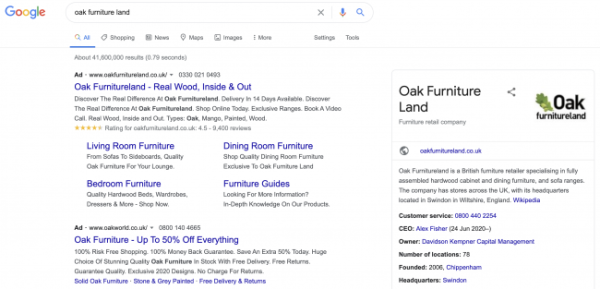"To set up your own brand-based keywords, the organisation is key in order to receive accurate, real-world analytics..."
This blog post explains the advantages and disadvantages of bidding on your own brand name as a keyword in Google Ads. From establishing a new brand to combating competitors, we’ll look at times when the technique should be used, and situations when bidding on your own brand might not be an efficient use of your advertising budget.
What do we mean by bidding on your own brand?
Bidding on your own brand in Google Ads means using your company name as a keyword. The example below shows that a Google search for the well-known furniture store Oak Furniture Land returns a Google Ad for the brand we’ve searched for. This tells us that the company has, in all likelihood, made a keyword bid on its own brand name.

In the next image, which shows an expanded view of the Google search results, we can see that the furniture retailer also achieves the top spot in the organic (i.e. not directly paid for) search results, in addition to the highest-ranking Google Ad.

Note that we’re not discussing bidding on keywords associated with the product brands you sell - these could be valid and useful keywords to include. We’re discussing including your company brand name as a keyword and bidding on it as part of your Google Ads campaign strategy.
When should bidding on your own brand be avoided?
Unnecessary cost
If your brand already has a good organic presence with a high search ranking, Google Ads that bid on your brand name can be an inefficient use of Ad spend and will decrease your profit - except in specific circumstances.
If a searcher enters your brand name, their goal is to visit your website. They are not looking to select from various product or service suppliers. In this case, the customer can arrive at your site via an organic search listing - provided your brand already achieves a near-top ranking. Your website will be easy to find, and a Google Ad would be unnecessary in this scenario. This way, bidding on your brand as a keyword is paying for traffic you would have received anyway - for free.
The searcher may not know - or care - about the difference between a Google Ad and an organic Google result. Their goal will be to arrive at their chosen website as quickly and as easily as possible - whether or not you have to pay for the ‘click’ on your Google Ad. In this case, it’s an inefficient use of ad spend that will subtract from your bottom line profit.
It’s crucial to remember that a direct search for your brand name comes from a motivation that is unlike that which generates a generic product search. If a potential customer is searching for a product or service type and does not have a brand in mind, they will consider your brand presence and those of your competitors. In this case, ensuring you have a high rank in the Google Ad results is key. Alternatively, if the searcher is already looking for your brand name, you’ve already won the competition battle, and there’s no need to compete with Google Ads.
Confusing metrics
Including your brand name as a keyword in your Google Ads will likely confuse your metrics and mask your account's success at generating traffic. This is because a significant proportion of visitors to your website are likely to be returning customers. If a returning visitor clicks on a Google Ad to get to your site, the Google Ad will get the credit, even though, in reality, the customer was already searching for you.
Not only will this give an inaccurate reading of traffic, but it will also give an overly high, false understanding of Return on Ad Spend (ROAS), which is calculated by dividing the conversion value by the cost of your Google Ads. Previous customers are far more likely to buy from you again compared to searchers who haven’t previously visited your website. If previous customers arrive at your site through a Google Ad and go on to make a purchase, the results will show that your Google Ads account is performing better than it really is in the real world. Regardless of your Google Ad, these customers would have shopped with you anyway. We’ll cover how to avoid this pitfall later on in the post.
Stunting your growth
A false reading of your Return on Ad Spend (ROAS) caused by many returning customers can also mask a lack of sales growth through new customer generation. Google Ads are usually deployed to generate new customer acquisition. If your displayed ROAS is high, the lack of new customer growth may only become apparent when you check your actual sales figures or your true number of customers. For this reason, where your own brand is used as a keyword, it should be segregated, possibly with the addition of audience filtering to avoid capturing return visitors - more on how to do this later.
High ROAS by repeat customers means that your total sales volume isn’t growing through new customer acquisition. The impact could be even greater for smaller companies with a lower volume of customers. Say 75% of your traffic comes from product or service-based keyword searches compared to 25% of searches generated from your brand as a keyword. Your brand keyword traffic, even though a smaller total proportion, could mask the reality of low sales conversion performance from three-quarters of your traffic purely because your brand keyword traffic generates an unrealistically high ROAS.
The danger is that high ROAS metrics can be used to hide the actual performance of your Google Ads campaign. If you’re using a marketing or Google Ads agency to manage your account, it’s vital that you can monitor the real metrics alongside those of your Google Ads account. If your ROAS is high, but you’re not winning new customers, check to see if your account is set to bid on your brand name.

Free Report
Spot Errors, See Strategies,
Our Free Report Reveals Key E-Commerce Fixes.
Book Your Call
When to use your brand name as a keyword
Establishing your brand
If your website doesn’t have a high organic ranking for a search of your brand name, bidding on it as a keyword makes good sense. If your website is new and hasn’t yet been ranked by Google, or if it perhaps features a generic description as a name or a common title already used by other businesses, your site may not achieve a high position even for direct searches of your own brand name.
In this case, a Google Ad supported by bids sufficient to secure a commanding position will help achieve traffic that could otherwise be lost or diverted to competing sites.
Defensive tactics
Another instance when using your name as a keyword makes sense is in defence against competitors bidding on your brand. If your brand already has good awareness and receives a high volume of searches, competitors can bid on your brand name in an attempt to take clicks destined for your site via their Ads campaigns.
This strategy, known as ‘conquesting’, is typically used when a new, smaller challenger brand emerges on the market and aims to take a share of the traffic by capitalising on the awareness of the well-known, incumbent brand. Trademark infringement may prevent the challenger from using the incumbent brand’s name in their ad copy (unless the name isn’t protected by a trademark). Still, the advertiser can bid on the brand name as a keyword.
As an example of this strategy, when searching for the furniture retailer Furniture Village, the Google Ad results include the chosen brand and close competitor Oak Furniture Land, as shown below. From this example, it’s likely that Oak Furniture Land is also competing for its competitor’s brand name as a keyword.

Conversely, the same tactic is being used against Oak Furniture Land - this time by a competitor which is seeking to benefit from awareness of the 'oak' reference. We can see below the tactic of Oak World, which achieves a Google Ad position directly behind the brand it’s aiming to conquer traffic from.

These examples show how the incumbent brand needs to bid on its own brand name as a keyword in defence against the competition. Their name may still appear in the first position in the organic results, but if it doesn’t bid on its own brand name in Google Ads, the top spot on the page will be supplanted by a competitor seeking to gain an advantage.

Getting Started With
Performance Max
Download Our Step-by-step guide to getting started with Performance Max Shopping Campaigns for your Shopify Store
GET YOUR FREE EBOOKFREE EBOOK
How to identify when to defend with a Google Ad?
The conquesting strategy is more usually used amongst larger firms; the market usually needs to be big enough that the incumbent has a volume of clicks worth challenging. Conversely, the challenger needs sufficient resources to make the tactic work.
That said, if your market is sufficiently contained, such as a niche or geographical market, competitors aiming to conquer clicks could emerge if you gain sufficiently high brand awareness and traffic share.
To identify whether your brand may be susceptible to conquest:
- If you search for your brand name and other ads from competing brands in your marketplace also appear, they will likely be bidding on your brand name. This would surely be the case if your name is specific and doesn’t include generic words.
- Use Google’s Auction Insights to inform you which competitors you’re overlapping with for your chosen keywords. To access the analytics from Auction Insights you must have the keyword, i.e. your brand name, placed within its own specific Ad Group. If you’re using Google Smart, you must adjust the system manually.
- If the cost of the bid on your brand name as a keyword increases, this is another sign of its interest with competitors. Bid values are driven by competition; the greater the keyword’s popularity, the higher the bid value. To ensure that your bidding process is managed as effectively as possible, you can read more in our post about how to set an initial budget for Google Advertising.
- Be vigilant: regular surveillance of the situation is required to avoid a competitor quickly moving in and taking advantage of your brand awareness to gain a share of your clicks.
Keyword Conquesting
If you’re entering a market with well-known incumbent brands, you can try this tactic yourself and bid on competitors’ brand names. It’s worth bearing in mind, though, that this tactic may be considered to be ‘aggressive’ and could lead to countermeasures!
Regarding organisation, as per a defensive strategy, the competitor brand keywords you want to gain clicks from should be segregated into specific Ad Groups or Ad Campaigns. As for ad copy, be aware of the trademark status before using a competitor’s brand name within your text. Instead, you could explain the advantages of why your brand should be used.
Managing ‘your brand’ keywords
To set up your brand-based keywords, the organisation is key to receiving accurate, real-world analytics, and these tips will help you achieve that.
- Organise your brand-based keywords into segregated Ad Groups or Ad Campaigns. If you don’t segregate them this way, your own brand-based keywords will be mixed with other, non-branded, generic keywords, making it much harder to identify the true results. Segregating these keywords is also essential to receive reliable data from Auction Insights.
- Returning visitors must always be factored in. You may require a presence for first-time visitors searching for your brand but not for those returning. In these cases, Audience lists can be created and used to filter traffic according to your objectives.
- Remember that Google’s Automated keyword selection tools will naturally select the company brand name as a keyword, either through the Smart campaign or through the suggestions of the Keyword Planner. If you’re using these tools, check the automated selection for your brand name and manage it appropriately by segregating it as described above or removing it completely.
Bidding on your brand as a keyword might be a necessary defensive strategy, or conversely, you might be using it to gain market share. It can also be used to establish awareness for your company, but whatever the reasons, if you’re planning to bid on your brand, make sure that the keywords are appropriately managed. Bidding on your own brand as a keyword is an inefficient tactic in terms of cost, and it will also disrupt the true results of your Google Ads campaign.
If your situation doesn’t fit the criteria for bidding on your brand, avoiding the tactic could be more efficient. Instead, use the tried and tested path of keyword research and selection based on the products and services your target market is searching for.
For questions about how to manage your Google Ads campaign, or if you’re looking for Google Ads account management, get in touch with us.

Book A Discovery Call
Looking for tailor-made PPC strategies? Our team is here to help you maximize your online store's potential. Book a discovery call with us for personalised insights and solutions.
Book Your Free ConsultationBook Your Call